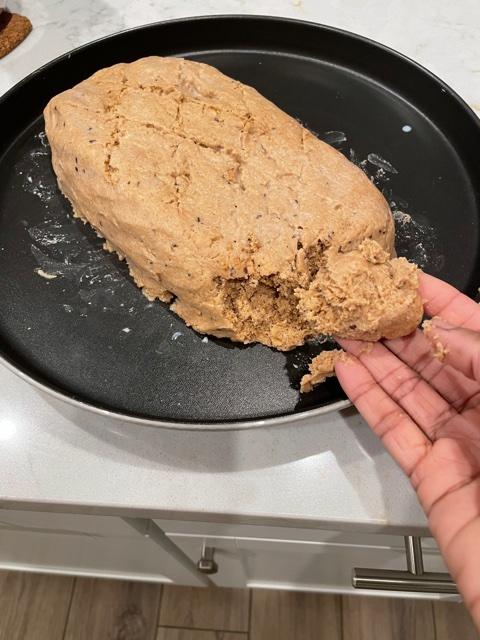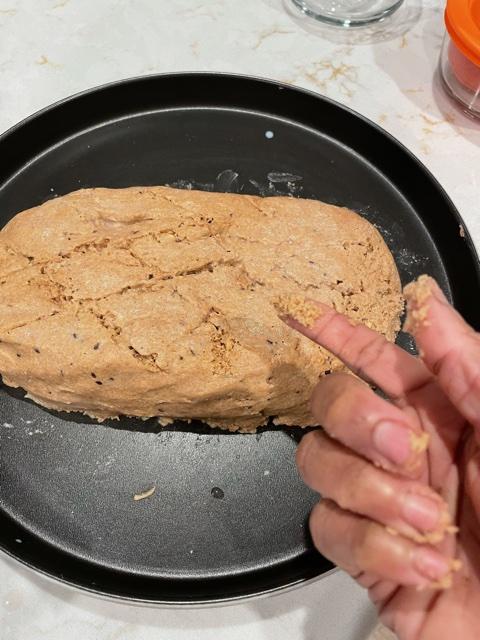 Hello ,
Hello ,
I am few months into making my own bread. I use store bought 100% whole wheat flour tombake my bread.
This time I wanted to Mill my own flour and bake from it. I used Red wheat.
Rinsed, sprouted, dried and ground using grain mill.
I used the same proportion of water: flour as I always do, but my flour is kind of sticky and does not bounce back, I know i am missing something but not sure what. Please help.

You can try freezing wheat before grinding so it does not heat to a high temperature while it's being milled.
I hope you are going to tel me that the picture is of unbaked dough. I hope that is not a baked loaf of bread.
In order to offer any constructive ideas, your ingredient list and also how you handled the dough is needed. Fresh milled flour has some characteristics that are very different from store-bought flour. It generally ferments faster and can deteriorate faster into a wet,soupy mess due to enzymes.How long after mixing the dough did it ferment? At what temp? How long did the loaf proof? Is this a natural levain (sourdough)? or made with commercial yeast?
Also,as alluded to, when grinding wheat berries, if the process heats the flour up beyond 125F (I think that is the limit), it can destroy the gluten protein and there will be no gluten stringy formation. Great for cake and pancakes but not bread.I measure out my wheat berries and freeze before grinding. I can still generate a 100F temp with my mill.
So more info needed. Current dough can make great pancakes.
Since you don’t mention that the store-bought flour was sprouted, I have to assume that it wasn’t. Consequently, the sprouted flour that you have made will behave differently.
Suggestion #1: Mill your own flour using unsprouted grain. That will give you flour whose characteristics are closer to the store-bought flour that you used previously. There will be some differences, but not nearly so many as you have encountered. Once you have the experience and confidence gained from working with home-milled flour, then branch out into using sprouted flour.
Suggestion #2: When you get to the point of wanting to use sprouted flour, start with buying some instead of making your own. Those flours are produced under stricter processes than we can manage at home, so their characteristics will be more consistent from batch to batch.
Suggestion #3: When you bake with sprouted flour, whether purchased or made at home, use recipes that are designed for sprouted flours. Those recipes should already have the necessary adaptations to account for the differences inherent in sprouted flours.
One can certainly sprout and grind their own flour, as you have shown. And, as you have found, it's a different kind of thing. Best of luck as you learn about these new processes and skills.
Paul
Non expert but I'll take a crack at it. I have no idea what you may already know. Maybe more than I do.
As mentioned above, I point out enzymes.
Sprouting activates enzymes in the grain that start turning grain starches into sugars to feed the growing plant embryo. If you don't stop the sprouting process at the chit stage (just a bit of sprout coming out) then you shift into malting (sprout at the length of kernel, rootlets coming out) where you are creating an enzyme rich situation. This is how you create diastatic malt. Diastatic malt is just malted and dried out kernels that when added to a dough provide sweetness and enzymes to break dough starches into sugars to feed yeast and improve browning.
These enzymes are catalysts meaning they don't get used up in the process. So in time they will break everything down in your dough if you're not careful.
Subject to experts correcting me...
You can just sprout and stop your kernels to avoid their going too far ie. into malting
You can weigh your sprouted + dried grain to see if it is truly dried or if there is still added moisture remaining
You can use a portion of milled flour mixed with commercial flours in order to develop a sense for it and still get some great fresh flavour